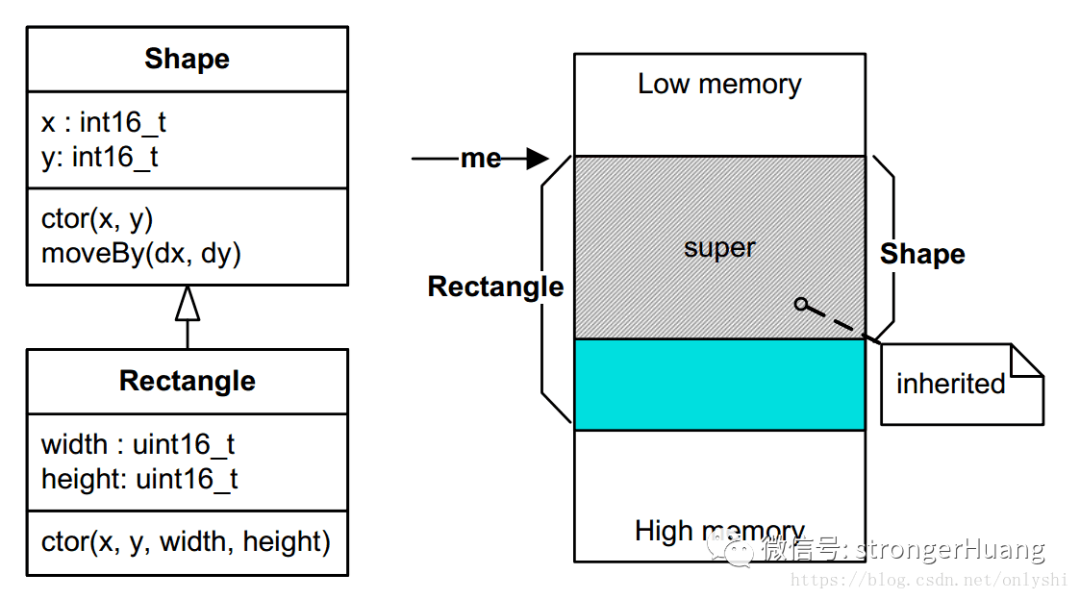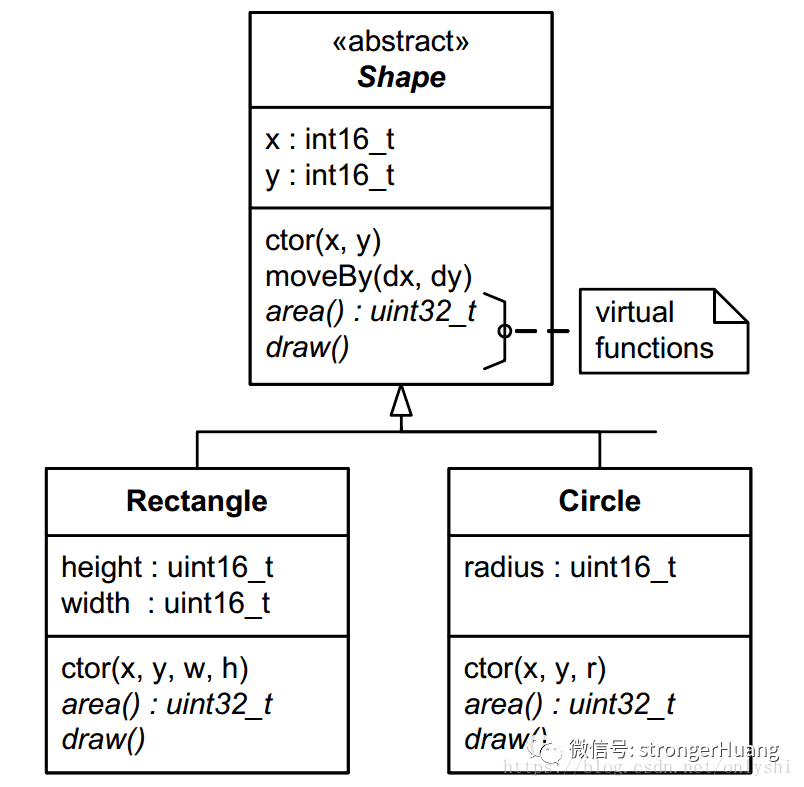不知道有多少人去了解過語言的發展史,早期C語言的語法功能其實比較簡單。隨著應用需求和場景的變化,C語言的語法功能在不斷升級變化。
雖然我們的教材有這么一個結論:C語言是面向過程的語言,C++是面向對象的編程語言,但面向對象的概念是在C語言階段就有了,而且應用到了很多地方,比如某些操作系統內核、通信協議等。
面向對象編程,也就是大家說的OOP(Object Oriented Programming)并不是一種特定的語言或者工具,它只是一種設計方法、設計思想,它表現出來的三個最基本的特性就是封裝、繼承與多態。
1、為什么用C實現OOP
閱讀文本之前肯定有讀者會問這樣的問題:我們有C++面向對象的語言,為什么還要用C語言實現面向對象呢?
C語言這種非面向對象的語言,同樣也可以使用面向對象的思路來編寫程序的。只是用面向對象的C++語言來實現面向對象編程會更簡單一些,但是C語言的高效性是其他面向對象編程語言無法比擬的。
當然使用C語言來實現面向對象的開發相對不容易理解,這就是為什么大多數人學過C語言卻看不懂Linux內核源碼。
所以這個問題其實很好理解,只要有一定C語言編程經驗的讀者都應該能明白:面向過程的C語言和面向對象的C++語言相比,代碼運行效率、代碼量都有很大差異。在性能不是很好、資源不是很多的MCU中使用C語言面向對象編程就顯得尤為重要。
2、所具備的條件
要想使用C語言實現面向對象,首先需要具備一些基礎知識。比如:(C語言中的)結構體、函數、指針,以及函數指針等,(C++中的)基類、派生、多態、繼承等。
首先,不僅僅是了解這些基礎知識,而是有一定的編程經驗,因為上面說了“面向對象是一種設計方法、設計思想”,如果只是停留在字面意思的理解,沒有這種設計思想肯定不行。
因此,不建議初學者使用C語言實現面向對象,特別是在真正項目中。建議把基本功練好,再使用。
利用C語言實現面向對象的方法很多,下面就來描述最基本的封裝、繼承和多態。
3、封裝
封裝就是把數據和函數打包到一個類里面,其實大部分C語言編程者都已近接觸過了。
C 標準庫中的 fopen(), fclose(), fread(), fwrite()等函數的操作對象就是 FILE。數據內容就是 FILE,數據的讀寫操作就是 fread()、fwrite(),fopen() 類比于構造函數,fclose() 就是析構函數。
這個看起來似乎很好理解,那下面我們實現一下基本的封裝特性。
#ifndefSHAPE_H
#defineSHAPE_H
#include
//Shape的屬性
typedefstruct{
int16_tx;
int16_ty;
}Shape;
//Shape的操作函數,接口函數
voidShape_ctor(Shape*constme,int16_tx,int16_ty);
voidShape_moveBy(Shape*constme,int16_tdx,int16_tdy);
int16_tShape_getX(Shapeconst*constme);
int16_tShape_getY(Shapeconst*constme);
#endif/*SHAPE_H*/
這是 Shape 類的聲明,非常簡單,很好理解。一般會把聲明放到頭文件里面 “Shape.h”。來看下 Shape 類相關的定義,當然是在 “Shape.c” 里面。
#include"shape.h"
//構造函數
voidShape_ctor(Shape*constme,int16_tx,int16_ty)
{
me->x=x;
me->y=y;
}
voidShape_moveBy(Shape*constme,int16_tdx,int16_tdy)
{
me->x+=dx;
me->y+=dy;
}
//獲取屬性值函數
int16_tShape_getX(Shapeconst*constme)
{
returnme->x;
}
int16_tShape_getY(Shapeconst*constme)
{
returnme->y;
}
再看下 main.c
#include"shape.h"/*Shapeclassinterface*/ #include/*forprintf()*/ intmain() { Shapes1,s2;/*multipleinstancesofShape*/ Shape_ctor(&s1,0,1); Shape_ctor(&s2,-1,2); printf("Shapes1(x=%d,y=%d)n",Shape_getX(&s1),Shape_getY(&s1)); printf("Shapes2(x=%d,y=%d)n",Shape_getX(&s2),Shape_getY(&s2)); Shape_moveBy(&s1,2,-4); Shape_moveBy(&s2,1,-2); printf("Shapes1(x=%d,y=%d)n",Shape_getX(&s1),Shape_getY(&s1)); printf("Shapes2(x=%d,y=%d)n",Shape_getX(&s2),Shape_getY(&s2)); return0; }
編譯之后,看看執行結果:
Shapes1(x=0,y=1) Shapes2(x=-1,y=2) Shapes1(x=2,y=-3) Shapes2(x=0,y=0)
整個例子,非常簡單,非常好理解。以后寫代碼時候,要多去想想標準庫的文件IO操作,這樣也有意識的去培養面向對象編程的思維。
4、繼承
繼承就是基于現有的一個類去定義一個新類,這樣有助于重用代碼,更好的組織代碼。在 C 語言里面,去實現單繼承也非常簡單,只要把基類放到繼承類的第一個數據成員的位置就行了。 例如,我們現在要創建一個 Rectangle 類,我們只要繼承 Shape 類已經存在的屬性和操作,再添加不同于 Shape 的屬性和操作到 Rectangle 中。 下面是 Rectangle 的聲明與定義:
#ifndefRECT_H
#defineRECT_H
#include"shape.h"http://基類接口
//矩形的屬性
typedefstruct{
Shapesuper;//繼承Shape
//自己的屬性
uint16_twidth;
uint16_theight;
}Rectangle;
//構造函數
voidRectangle_ctor(Rectangle*constme,int16_tx,int16_ty,
uint16_twidth,uint16_theight);
#endif/*RECT_H*/
#include"rect.h"
//構造函數
voidRectangle_ctor(Rectangle*constme,int16_tx,int16_ty,
uint16_twidth,uint16_theight)
{
/*firstcallsuperclass’ctor*/
Shape_ctor(&me->super,x,y);
/*next,youinitializetheattributesaddedbythissubclass...*/
me->width=width;
me->height=height;
}
我們來看一下 Rectangle 的繼承關系和內存布局:

因為有這樣的內存布局,所以你可以很安全的傳一個指向 Rectangle 對象的指針到一個期望傳入 Shape 對象的指針的函數中,就是一個函數的參數是 “Shape *”,你可以傳入 “Rectangle *”,并且這是非常安全的。這樣的話,基類的所有屬性和方法都可以被繼承類繼承!
#include"rect.h"
#include
intmain()
{
Rectangler1,r2;
//實例化對象
Rectangle_ctor(&r1,0,2,10,15);
Rectangle_ctor(&r2,-1,3,5,8);
printf("Rectr1(x=%d,y=%d,width=%d,height=%d)n",
Shape_getX(&r1.super),Shape_getY(&r1.super),
r1.width,r1.height);
printf("Rectr2(x=%d,y=%d,width=%d,height=%d)n",
Shape_getX(&r2.super),Shape_getY(&r2.super),
r2.width,r2.height);
//注意,這里有兩種方式,一是強轉類型,二是直接使用成員地址
Shape_moveBy((Shape*)&r1,-2,3);
Shape_moveBy(&r2.super,2,-1);
printf("Rectr1(x=%d,y=%d,width=%d,height=%d)n",
Shape_getX(&r1.super),Shape_getY(&r1.super),
r1.width,r1.height);
printf("Rectr2(x=%d,y=%d,width=%d,height=%d)n",
Shape_getX(&r2.super),Shape_getY(&r2.super),
r2.width,r2.height);
return0;
}
輸出結果:
Rectr1(x=0,y=2,width=10,height=15) Rectr2(x=-1,y=3,width=5,height=8) Rectr1(x=-2,y=5,width=10,height=15) Rectr2(x=1,y=2,width=5,height=8)
5、多態
C++ 語言實現多態就是使用虛函數。在 C 語言里面,也可以實現多態。 現在,我們又要增加一個圓形,并且在 Shape 要擴展功能,我們要增加 area() 和 draw() 函數。但是 Shape 相當于抽象類,不知道怎么去計算自己的面積,更不知道怎么去畫出來自己。而且,矩形和圓形的面積計算方式和幾何圖像也是不一樣的。 下面讓我們重新聲明一下 Shape 類:
#ifndefSHAPE_H
#defineSHAPE_H
#include
structShapeVtbl;
//Shape的屬性
typedefstruct{
structShapeVtblconst*vptr;
int16_tx;
int16_ty;
}Shape;
//Shape的虛表
structShapeVtbl{
uint32_t(*area)(Shapeconst*constme);
void(*draw)(Shapeconst*constme);
};
//Shape的操作函數,接口函數
voidShape_ctor(Shape*constme,int16_tx,int16_ty);
voidShape_moveBy(Shape*constme,int16_tdx,int16_tdy);
int16_tShape_getX(Shapeconst*constme);
int16_tShape_getY(Shapeconst*constme);
staticinlineuint32_tShape_area(Shapeconst*constme)
{
return(*me->vptr->area)(me);
}
staticinlinevoidShape_draw(Shapeconst*constme)
{
(*me->vptr->draw)(me);
}
Shapeconst*largestShape(Shapeconst*shapes[],uint32_tnShapes);
voiddrawAllShapes(Shapeconst*shapes[],uint32_tnShapes);
#endif/*SHAPE_H*/
看下加上虛函數之后的類關系圖:

5.1 虛表和虛指針
虛表(Virtual Table)是這個類所有虛函數的函數指針的集合。
虛指針(Virtual Pointer)是一個指向虛表的指針。這個虛指針必須存在于每個對象實例中,會被所有子類繼承。
在《Inside The C++ Object Model》的第一章內容中,有這些介紹。
5.2 在構造函數中設置vptr
在每一個對象實例中,vptr 必須被初始化指向其 vtbl。最好的初始化位置就是在類的構造函數中。事實上,在構造函數中,C++ 編譯器隱式的創建了一個初始化的vptr。在 C 語言里面, 我們必須顯示的初始化vptr。
下面就展示一下,在 Shape 的構造函數里面,如何去初始化這個 vptr。
#include"shape.h" #include//Shape的虛函數 staticuint32_tShape_area_(Shapeconst*constme); staticvoidShape_draw_(Shapeconst*constme); //構造函數 voidShape_ctor(Shape*constme,int16_tx,int16_ty) { //Shape類的虛表 staticstructShapeVtblconstvtbl= { &Shape_area_, &Shape_draw_ }; me->vptr=&vtbl; me->x=x; me->y=y; } voidShape_moveBy(Shape*constme,int16_tdx,int16_tdy) { me->x+=dx; me->y+=dy; } int16_tShape_getX(Shapeconst*constme) { returnme->x; } int16_tShape_getY(Shapeconst*constme) { returnme->y; } //Shape類的虛函數實現 staticuint32_tShape_area_(Shapeconst*constme) { assert(0);//類似純虛函數 return0U;//避免警告 } staticvoidShape_draw_(Shapeconst*constme) { assert(0);//純虛函數不能被調用 } Shapeconst*largestShape(Shapeconst*shapes[],uint32_tnShapes) { Shapeconst*s=(Shape*)0; uint32_tmax=0U; uint32_ti; for(i=0U;imax) { max=area; s=shapes[i]; } } returns; } voiddrawAllShapes(Shapeconst*shapes[],uint32_tnShapes) { uint32_ti; for(i=0U;i
5.3 繼承 vtbl 和 重載 vptr
上面已經提到過,基類包含 vptr,子類會自動繼承。但是,vptr 需要被子類的虛表重新賦值。并且,這也必須發生在子類的構造函數中。下面是 Rectangle 的構造函數。
#include"rect.h" #include //Rectangle虛函數 staticuint32_tRectangle_area_(Shapeconst*constme); staticvoidRectangle_draw_(Shapeconst*constme); //構造函數 voidRectangle_ctor(Rectangle*constme,int16_tx,int16_ty, uint16_twidth,uint16_theight) { staticstructShapeVtblconstvtbl= { &Rectangle_area_, &Rectangle_draw_ }; Shape_ctor(&me->super,x,y);//調用基類的構造函數 me->super.vptr=&vtbl;//重載vptr me->width=width; me->height=height; } //Rectangle's虛函數實現 staticuint32_tRectangle_area_(Shapeconst*constme) { Rectangleconst*constme_=(Rectangleconst*)me;//顯示的轉換 return(uint32_t)me_->width*(uint32_t)me_->height; } staticvoidRectangle_draw_(Shapeconst*constme) { Rectangleconst*constme_=(Rectangleconst*)me;//顯示的轉換 printf("Rectangle_draw_(x=%d,y=%d,width=%d,height=%d)n", Shape_getX(me),Shape_getY(me),me_->width,me_->height); }
5.4 虛函數調用
有了前面虛表(Virtual Tables)和虛指針(Virtual Pointers)的基礎實現,虛擬調用(后期綁定)就可以用下面代碼實現了。
uint32_tShape_area(Shapeconst*constme) { return(*me->vptr->area)(me); }
這個函數可以放到.c文件里面,但是會帶來一個缺點就是每個虛擬調用都有額外的調用開銷。為了避免這個缺點,如果編譯器支持內聯函數(C99)。我們可以把定義放到頭文件里面,類似下面:
staticinlineuint32_tShape_area(Shapeconst*constme) { return(*me->vptr->area)(me); }
如果是老一點的編譯器(C89),我們可以用宏函數來實現,類似下面這樣:
#defineShape_area(me_)((*(me_)->vptr->area)((me_)))
看一下例子中的調用機制:
? 5.5 main.c
#include"rect.h" #include"circle.h" #include intmain() { Rectangler1,r2; Circlec1,c2; Shapeconst*shapes[]= { &c1.super, &r2.super, &c2.super, &r1.super }; Shapeconst*s; //實例化矩形對象 Rectangle_ctor(&r1,0,2,10,15); Rectangle_ctor(&r2,-1,3,5,8); //實例化圓形對象 Circle_ctor(&c1,1,-2,12); Circle_ctor(&c2,1,-3,6); s=largestShape(shapes,sizeof(shapes)/sizeof(shapes[0])); printf("largetsShapes(x=%d,y=%d)n",Shape_getX(s),Shape_getY(s)); drawAllShapes(shapes,sizeof(shapes)/sizeof(shapes[0])); return0; }
輸出結果:
largetsShapes(x=1,y=-2) Circle_draw_(x=1,y=-2,rad=12) Rectangle_draw_(x=-1,y=3,width=5,height=8) Circle_draw_(x=1,y=-3,rad=6) Rectangle_draw_(x=0,y=2,width=10,height=15)
6、總結
還是那句話,面向對象編程是一種方法,并不局限于某一種編程語言。用 C 語言實現封裝、單繼承,理解和實現起來比較簡單,多態反而會稍微復雜一點,如果打算廣泛的使用多態,還是推薦轉到 C++ 語言上,畢竟這層復雜性被這個語言給封裝了,你只需要簡單的使用就行了。但并不代表,C 語言實現不了多態這個特性。 文章來源:直接來源,嵌入式情報局
-- End--
本號對所有原創、轉載文章的陳述與觀點均保持中立,推送文章僅供讀者學習和交流。文章、圖片等版權歸原作者享有,如有侵權,聯系刪除。
審核編輯黃宇
-
封裝
+關注
關注
126文章
7903瀏覽量
142967 -
C語言
+關注
關注
180文章
7604瀏覽量
136845 -
繼承
+關注
關注
0文章
10瀏覽量
2709
發布評論請先 登錄
相關推薦




 C語言實現面向對象三大特性 : 封裝、繼承、多態
C語言實現面向對象三大特性 : 封裝、繼承、多態













評論